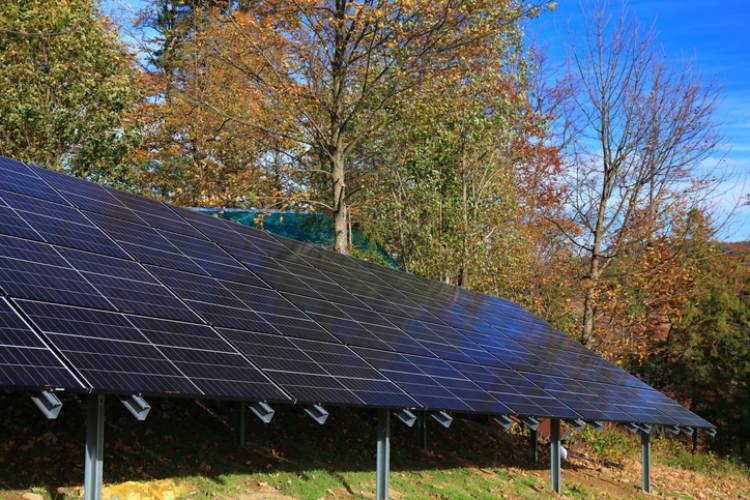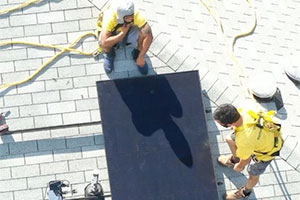Ground-Mounted Solar Panels
Ground-Mounted Solar Panel Installers in Atlanta, GA
At Better Tomorrow Solar, we specialize in high-quality ground-mounted solar panel systems that transform expansive spaces into efficient power-generating assets. Whether you’re upgrading your energy independence or preparing for future needs, our ground-mount services offer flexibility and durability. We are here to walk you through what makes ground-mount solar a smart investment in Atlanta, GA.

What Are the Key Benefits?
One benefit of ground-mounted systems is that they can be placed anywhere on your property for maximum sun exposure, and aren’t constrained by slope or orientation. Manual tilt or tracking upgrades let panels follow seasonal or daily sun paths, boosting energy production. Some other benefits include:
- Easy Maintenance and Longevity – Installed at ground level, these arrays are easier to clean, inspect, and repair. Quicker upkeep helps maintain peak performance while saving on labor costs.
- Expandable Design – Planning to add EV charging, battery storage, or extra panels down the line? Ground systems can be easily scaled with no need to retrofit your roof or worry about structural limits.
- Increased Safety and Versatility – These setups keep electrical wiring and racks away from structures, reducing fire risk and simplifying electrical grounding. Plus, they can double as shaded carports or patio coverings.
- Support for Larger, Efficient Panels – With sturdy racking, ground systems accommodate large-format or bifacial panels, which are often impractical on roofs.
Considerations & Challenges
While there are numerous benefits to ground-mount solar installation, it’s important to consider the challenges as well. Some things to keep in mind are:
- Higher Initial Costs – Ground systems require additional materials, which can increase upfront costs compared to roof-mounted setups.
- Land Consumption – You’ll need a minimum of roughly 350 square feet for a standard array, and more if using mechanical trackers or future expansions.
- Permitting and Zoning Requirements – Many jurisdictions treat ground arrays like outbuildings, invoking stricter rules that may extend project timelines.
- Visual Impact – A ground-mounted array makes a visible statement. While some integrate them into carports or pergolas, others may find them less attractive than roof installations.
Ground vs. Roof Solar: A Side-by-Side Comparison
When comparing ground-mounted solar to roof-mounted systems, several key differences stand out. Ground-mounted solar offers optimal sun exposure since the panels can be installed at the perfect angle and orientation, with the added benefit of seasonal adjustability or tracking systems. Maintenance is also easier, as ground-level access makes cleaning and repairs more convenient. However, these systems typically come with higher upfront costs due to the need for additional materials like racking, anchors, and trenching. They also require a significant amount of space.
Roof-mounted systems tend to be more cost-effective since they use the existing roof structure and don’t consume usable land. They are less visible and often face fewer zoning restrictions, but they are limited by roof pitch, orientation, and space. Maintenance can be more challenging, and future expansion is often more complicated. Ground-mounted systems offer more flexibility for expansion and easier integration with features like EV chargers and battery storage, making them an attractive option for locations with ample land.
Common FAQs
Still have questions about solar ground mount systems? Here are the answers to some of the most commonly asked questions we receive:
- What Types of Ground Mounts Are Available? – There are two types of mounts: standard fixed and pole mount. Standard fixed mounts are anchored via concrete piers, driven piles, or ballast and are solid and cost-effective. Pole mounts are one or two poles mounted deep into the ground, and they offer height clearance and optional solar tracking for higher energy yields.
- How Much Land Do These Systems Need? – A typical array needs around 350 square feet for a moderate system. Tracking and expandable setups may require 500–1,000 square feet.
- Are They Weather-Proof? – Properly engineered anchors handle wind, snow, and rain loads. Tracking systems are built to stow safely in storms.
- Does It Affect My Property Value? – Panels can shade gardens or lawn space, but using them as carports or dual-use structures can add value. Plus, increased energy independence often enhances resale value.
Why Choose Better Tomorrow Solar?
Choosing Better Tomorrow Solar means custom designs for maximum efficiency. We assess your land, sun exposure, and energy needs to select the right mount to optimize production. We manage all paperwork, inspections, and utility coordination. Our engineers and certified installers ensure a safe, code-compliant project. Your system can expand painlessly because we plan today with tomorrow’s needs in mind. Our ground arrays are built to last in every season, with rack and inverter options that complement your landscape. From federal tax credits to state and local rebates, we guide you to maximize incentives and long-term savings.
Reach Out to Learn More
If you have open land and a vision for energy independence, Better Tomorrow Solar is ready to build it. If you have questions like “Do ground-mounted solar panels need planning permission?” or “How tall are ground-mounted solar panels?” our team has the answers. Reach out to us today and learn how you can benefit from a new solar system.







